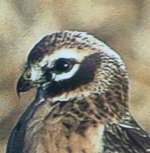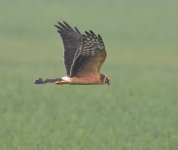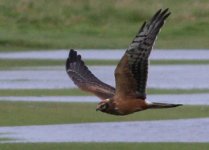JANJ
Well-known member
To me this is fairly clear-cut Pallid harrier.
The pale crown is of little relevance since both Pallid and Monty's may show this feature in juvenile plumage. On the other the combination of rather pale head (pale crown and relatively pale nape) and the dark cheek-patch largely reaching the malar area is not at all common in Montagu's, but still fairly typical for Pallid.
The wingtip to tail ration has already been mentionned and while this may not be a bullet-proof feature, the wingtip falling well short of the tailtip strongly favours Pallid has other have mentionned. In term of general appearance, this translates into a rather stocky bird lacking the attenuated rear end of Monty's.
But I will mainly also insist of the face pattern. Once you have your eyes tuned into it, the aggressive face pattern of a juv Pallid is readily told from the "goofy" face of a juv Monty's and will be in most cases instantly recognizable. I believe it to be the case here.
To give a bit more details:
- note how the supercilium appear narrow, rather long (starting well in front of the eye) with and up-turned rear end. This would be extremely unusual for a Monty's which normaly shows a shortish, broader supercilium that wraps around the rear-end of the eye.
- note also the size discrepancy between the supercilium and the white Crescent below the eye. In the overwhelming majority of juv Monty's, the supercilium and the crescent are approximatively of the same size while this descrepancy is very typical for juv Pallid.
And while it might be a bit far-fetched, there is a bit of primary pattern visible. Best seen on that pic I think: http://www.birdforum.net/gallery/showphoto.php/photo/538007/cat/recent/limit/recent
The outer primaries seem to show a rather short and well defined black-tip implying that the fingers are mostly pale...
The wingtip tail ratio can be seen here, first Montagu's: http://www.indianaturewatch.net/view_cat.php?tag=Montagu\'s Harrier&view_all and Pallid: http://www.indianaturewatch.net/view_cat.php?tag=Pallid Harrier&view_all
JanJ
Last edited:









